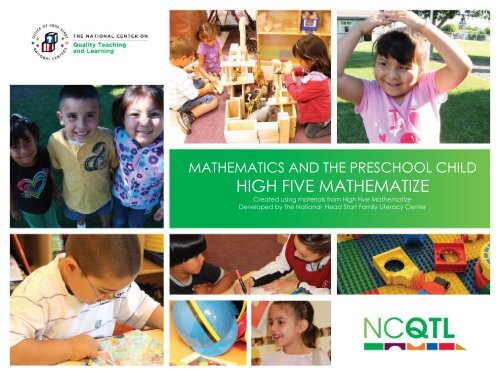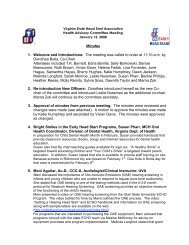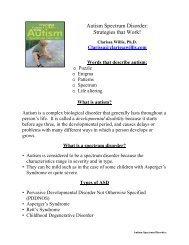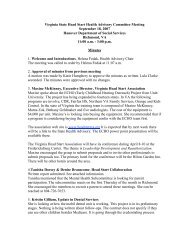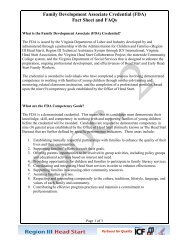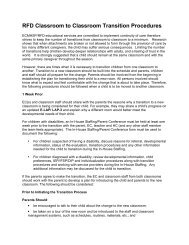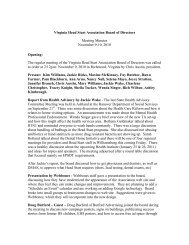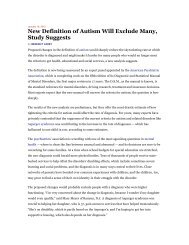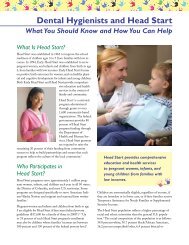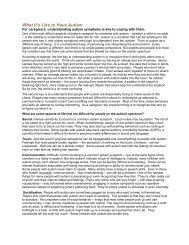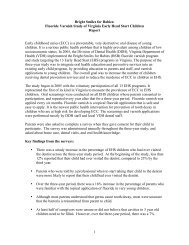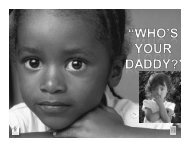Headstart's High Five Mathematize
Headstart's High Five Mathematize
Headstart's High Five Mathematize
Create successful ePaper yourself
Turn your PDF publications into a flip-book with our unique Google optimized e-Paper software.
MATHEMATICS AND THE PRESCHOOL CHILD<br />
HIGH FIVE MATHEMATIZE<br />
Created using materials from <strong>High</strong> <strong>Five</strong> <strong>Mathematize</strong><br />
Developed by the National Head Start Family Literacy Center
MATH MATERIALS<br />
• Pick-up materials<br />
• Experiment with your materials<br />
• Make a construction and<br />
share one math concept about<br />
what you made
Own Comfort Level with Math<br />
MATH AND ME<br />
Comfort Level Teaching Preschool Math<br />
• Scatterplot
THE IMPORTANCE OF EARLY<br />
CHILDHOOD MATHEMATICS<br />
• There is a significant math gap at<br />
kindergarten entry for low income children<br />
(Denton & West, 2002).<br />
• Early math skills in kindergarten predicted 5 th<br />
grade achievement in math and AND<br />
reading (Claessens, Duncan & Engle,<br />
2006).
• Mathematical ideas are<br />
in children’s play and<br />
everyday experiences.<br />
• Young children develop<br />
some math concepts<br />
through self-guided<br />
discoveries.<br />
• Adult support is essential<br />
to maximize learning – to<br />
move mathematical<br />
development along.
MATHEMATIZE<br />
Definition: to bring out the math in what children are<br />
doing (commenting, questioning) Whee! Look how fast the<br />
• Example:<br />
ball rolls down the slide.<br />
You stayed up and the ball<br />
went down!<br />
Which slides down faster –<br />
a ball or a boy? Why does<br />
the ball go so fast?<br />
Math Connections<br />
� Shape (geometry)<br />
� Spatial concepts:<br />
up, down<br />
� Speed, comparing<br />
(measurement)
Adults mathematize children’s experiences when<br />
they:<br />
• emphasize math concepts<br />
and relations<br />
• use mathematical language<br />
• make comments, ask and<br />
answer questions, and pose<br />
math-related problems<br />
• provide a variety of<br />
materials and tools for<br />
exploration of math ideas
<strong>Mathematize</strong> Example:<br />
In Daddy’s Shoes<br />
Those shoes are so<br />
BIG and so LONG!<br />
They are much bigger<br />
than your little feet!<br />
How far can you walk<br />
in Daddy’s shoes?<br />
Math Connections<br />
• Size: big, little, long<br />
(measurement)<br />
• Comparing two objects:<br />
feet and shoes<br />
• Distance
MATHEMATIZE EXAMPLE:<br />
DISCOVERING SHADOWS<br />
How long is your shadow?<br />
Can you make it shorter<br />
or longer? Try to make<br />
your shadow as long as<br />
mine.<br />
Let’s take five steps back<br />
and see what happens to<br />
our shadows.<br />
Math Connections<br />
• Size, comparing:<br />
longer, shorter<br />
(measurement)<br />
• Number<br />
• Problem solving
MATHEMATIZE EXAMPLE:<br />
BUILDING WITH BLOCKS<br />
Tell me how you chose the<br />
blocks for your structure.<br />
I noticed that you used a<br />
long, flat block on the<br />
bottom.<br />
How did you make the two<br />
sides look the same?<br />
Math Connections<br />
• Sorting, matching<br />
• Shape, spatial<br />
relations (geometry)<br />
• Symmetry (patterns)
MATHEMATIZE EXAMPLE:<br />
SINGING WITH FRIENDS<br />
Listen to the pattern as I<br />
clap. Clap-clap, clap-clap.<br />
“<strong>Five</strong> little monkeys jumpin’<br />
on the bed!” What comes<br />
next?<br />
Oh, no! Another monkey fell<br />
off. How many are left?<br />
Math Connections<br />
• Repeating lyrics and<br />
movements, rhythms<br />
(patterns)<br />
• Number words<br />
• Counting backwards
• Numbers and<br />
Operations<br />
• Geometry & Spatial<br />
Sense<br />
• Patterns<br />
• Measurement<br />
MATH AREAS
NUMBERS AND OPERATIONS
COUNTING OBJECTS<br />
In preschool children’s<br />
counting skills improve<br />
when they…<br />
� Count small groups and<br />
label them with numbers<br />
� Compare groups of<br />
objects to determine<br />
which has more<br />
� Share evenly with friends
WHAT ARE CHILDREN LEARNING?<br />
• Subitizing<br />
– To look at a small<br />
group of objects<br />
and automatically<br />
know how many<br />
there are without<br />
counting<br />
• Cardinality<br />
– Knowing that the<br />
last number<br />
counted gives the<br />
total number of<br />
objects in the<br />
group. Answers the<br />
question of “how<br />
many?”
WHAT ARE CHILDREN LEARNING?<br />
• One-to-One<br />
Correspondence<br />
– Matching one and<br />
only one number<br />
word to each<br />
object<br />
• Combining and<br />
Separating<br />
– Refers to adding,<br />
subtracting, multiplying<br />
or dividing objects<br />
Examples:<br />
– “How many would you<br />
have if I gave you one<br />
more?”<br />
– “I have three graham<br />
crackers but if I eat<br />
one, how many will I<br />
have left?”
PRESCHOOL COUNTING<br />
• Watch the video<br />
• Identify what<br />
counting skill(s) the<br />
child understands<br />
• Determine which<br />
skills a teacher<br />
could help the child<br />
learn next
REPRESENTING NUMBER<br />
Help children<br />
learn to connect:<br />
– Concrete<br />
Objects<br />
– Spoken Words<br />
– Symbols, like<br />
dots or tally<br />
marks<br />
– Written<br />
numerals<br />
3<br />
• Written<br />
Numerals<br />
* * *<br />
• Concrete<br />
Objects<br />
“Three”<br />
• Spoken<br />
Number<br />
Words
DEVELOPING NUMBER AND<br />
OPERATION CONCEPTS<br />
• Provide engaging materials for children to count and compare<br />
• Engage children in finger plays that involve counting<br />
• Model counting and take advantage of times to count throughout the<br />
day<br />
• Use the question “how many” to encourage children to count, compare,<br />
and talk about quantity<br />
• Model and teach counting strategies, such as touching objects, lining up<br />
objects, pulling each object to the side after it is counted<br />
• Pose problems involving number, for example, “How many counting<br />
bears are in your cup?” and “If you give me one, how many will you<br />
have?”<br />
• Encourage children to write numbers that are meaningful, such as their<br />
age, how many siblings they have, how many days until grandma visits<br />
• Provide materials to play games, such as cards, dominos, dice, and<br />
books
LEARNING ACTIVITY TIME<br />
NOW IT’S YOUR TURN!<br />
• With a partner create a preschool math<br />
counting game using your materials<br />
• Determine the rules for your game<br />
• Identify which counting skills it teaches<br />
• Play your game!
GEOMETRY AND SPATIAL SENSE<br />
During the preschool<br />
years, children learn to…<br />
– Name common 2-D and<br />
3-D shapes<br />
– Identify shapes by their<br />
attributes<br />
– Develop spatial sense<br />
• Building with blocks<br />
• Working puzzles<br />
• Climbing<br />
• Playing ball with a friend
points<br />
lines<br />
angles<br />
surfaces<br />
solids<br />
GEOMETRY IS ABOUT . . .
WHAT ARE CHILDREN LEARNING?<br />
�Recognizing and Naming Shapes<br />
�Two-Dimensional Shapes<br />
� Have height and width, but no depth<br />
�Three-Dimensional Shapes<br />
� Have height, width, and depth<br />
� Have faces, edges, and corners (or vertices)
WHAT ARE CHILDREN LEARNING?<br />
• Geometric and Shape Attributes<br />
– Length of sides<br />
– Number of sides<br />
– Size of angles<br />
– Number of angles<br />
– Two versus three dimensions<br />
– Curved or straight lines<br />
– Diameter, radius and circumference for<br />
curvilinear shapes, like circles or spheres
FINDING RECTANGLES AND CIRCLES<br />
• Watch the video<br />
• What geometry<br />
concepts are<br />
illustrated in this<br />
video?<br />
• How does the teacher<br />
intentionally focus the<br />
children on<br />
geometry?
Learning Activity<br />
Get ready for a hands-on experience making<br />
shapes with Wooden Pattern Blocks!
MAKE SHAPES BY PUTTING TWO OR<br />
MORE PIECES TOGETHER.<br />
• Use your wooden pattern blocks to compose new<br />
shapes.<br />
– Put the shapes together in different combinations by<br />
sliding, rotating (turning), or flipping them. Take them<br />
apart and start again.<br />
• Challenge yourself!<br />
– See how many different shapes you can make using just<br />
one shape.<br />
– Try to make at least 5 different rectangles using a<br />
combination of similar and different shapes.
Slide! Rotate!<br />
Young children learn to manipulate<br />
shapes using these transformations, too!<br />
You can observe this when you watch<br />
them match shapes in a shape sorter,<br />
work puzzles, and create designs,<br />
patterns, and constructions with blocks or<br />
2-D shapes.<br />
Flip!
DEVELOPING GEOMETRY AND SPATIAL SENSE<br />
CONCEPTS<br />
• Help children notice attributes of shapes such as number of<br />
sides and corners, curved versus straight lines, etc.<br />
• Provide examples of 2-D shapes that are irregular or in<br />
different orientations so children can expand their thinking<br />
about shapes<br />
• Provide opportunities to put together and take apart<br />
different shapes<br />
• Plan experiences that encourage children to move their<br />
bodies through space in a variety of ways (obstacle<br />
courses, acting like different animals, “Going on A Bear<br />
Hunt, etc.)<br />
• Talk with children about:<br />
– Similarities and differences between 2-D and 3-D shapes<br />
– How to figure out where a puzzle piece fits<br />
– What they are doing and where things are using descriptive<br />
language
PATTERNS<br />
• Preschoolers need<br />
opportunities to engage<br />
in a variety of<br />
experiences with pattern<br />
(music, movement, art,<br />
stories, blocks).<br />
• Through these<br />
experiences, they learn<br />
to recognize and<br />
reproduce patterns that<br />
they hear or see and<br />
even create their own<br />
patterns.
WHAT IS A PATTERN?<br />
A pattern is a regular and<br />
predictable arrangement of things.<br />
– Regular means that the arrangement<br />
occurs in a consistent way—in a<br />
repeating or growing manner.<br />
– Predictable means that after the pattern<br />
is established, you can figure out what<br />
comes next.
WHAT CAN MAKE A PATTERN?<br />
Many things can make a<br />
pattern:<br />
– Objects<br />
– Actions<br />
– Sounds<br />
– Images<br />
– Numbers<br />
– Events<br />
Patterns are everywhere!
REPEATING PATTERNS<br />
• Watch the video<br />
• Identify different ways<br />
in which children are<br />
engaged with<br />
patterns<br />
• List other engaging<br />
ways to teach<br />
patterning
REPEATING PATTERNS<br />
Repeating patterns replicate a certain sequence<br />
(core unit) again and again.<br />
This girl made an ABBABB<br />
pattern. The repeating sequence<br />
is “blue ring, red ring, red ring.”
GROWING PATTERNS<br />
Growing patterns change from one value to another<br />
in a predictable way. This often involves a change in<br />
number, as in the patterns pictured below.<br />
This boy made a type of<br />
growing pattern by<br />
arranging sand dollars in<br />
order of size.<br />
Seriation<br />
a type of classifying<br />
and patterning,<br />
requires objects to be<br />
arranged in an<br />
increasing or<br />
decreasing order
– Recognize<br />
– Copy<br />
– Describe<br />
– Create<br />
– Extend<br />
PATTERNING SKILLS<br />
Children learn about patterns by working<br />
with them. Through a multitude of<br />
experiences they learn to do the<br />
following with patterns:<br />
B I N G O<br />
I N G O<br />
N G O<br />
G O<br />
O
DEVELOPING PATTERN CONCEPTS<br />
• Provide opportunities for children to sort or arrange<br />
items like lids, buttons, or toy animals by an attribute,<br />
such as color of lids, number of holes in buttons,<br />
where animals live<br />
• Create patterns with children and encourage them<br />
to make and describe their own patterns<br />
• Plan for patterning not only with physical objects,<br />
but choose songs, stories, and games that involve<br />
patterns<br />
• Talk about the regular, predictable parts of the<br />
school day and ask what comes next<br />
• Represent movement, object, or sound patterns with<br />
pictures or symbols
PATTERNING: ACTIVITY TIME<br />
• Create a pattern using the<br />
materials at your table<br />
• Once complete explain<br />
your pattern another<br />
person at your table,<br />
include what type of<br />
pattern it is and how you<br />
created it<br />
• Write down and share<br />
ways you are going to<br />
incorporate more patterns<br />
into your classroom
MEASUREMENT
Young children’s understanding of measurement is<br />
grounded in their real-life experiences.<br />
• A child plays with rocks in the science center and<br />
says, “This rock is so heavy!”<br />
• Children in the dramatic play area discuss family<br />
roles based on size, “You are the baby because<br />
you’re smaller. I’m the mommy because I’m<br />
bigger.”<br />
• During lunch time, children talk about differences<br />
in amounts of food on their plates and how much<br />
milk they have.
WHAT CHILDREN ARE LEARNING<br />
• Length, Height, Width, and Area<br />
– Enjoy measuring distances and area<br />
using non-standard measurement tools,<br />
such as lengths of string, links, own<br />
hands.<br />
– Benefit from opportunities to explore<br />
standard measurement tools, such as<br />
measuring tapes, rulers, and scales.<br />
– Lots of practice and experimentation!!
WHAT CHILDREN ARE LEARNING<br />
• Weight<br />
– Intrigued by the differences in<br />
weights of objects that are similar in<br />
size.<br />
– Plan experiences that allow children<br />
to make comparisons.<br />
– Provide opportunities for exploration<br />
• Example: A balance scale and many<br />
objects of different weights
WHAT CHILDREN ARE LEARNING<br />
• Volume and Capacity<br />
– Children often experience<br />
volume and capacity in their<br />
play.<br />
– Capacity- how much a<br />
container can hold<br />
– Volume- the space that a<br />
solid object or liquid takes up
WHAT CHILDREN ARE LEARNING<br />
• Time<br />
– Children think of time in terms of their own<br />
experiences<br />
– Time is an abstract idea for preschool<br />
children<br />
– Explain time in a meaningful manner<br />
• Example:<br />
– Child-friendly daily schedule<br />
– Consistent transitions (2 min warnings)<br />
– Discuss past and future events, “when I was a<br />
baby”, “when I grow up”<br />
– Talk about yesterday, tomorrow, and next week
ELEPHANT FEET: HOW TALL AM I?<br />
� Watch the video<br />
� Identify what<br />
measuring skills<br />
children are learning<br />
� Brainstorm ways to<br />
extend this activity<br />
to integrate other<br />
measurement<br />
concepts
DEVELOPING MEASUREMENT<br />
CONCEPTS<br />
• Provide materials that encourage children to<br />
explore measurement, like standardized and<br />
non-standardized tools<br />
• Use language that compares quantities (more<br />
than, less than, same as, etc.)<br />
• Use measurement terminology to identify<br />
differences in attributes (longer, shortest,<br />
heavier, lightest, etc.)<br />
• Suggest measurement strategies when<br />
children compare size, capacity, weight, and<br />
other dimensions
LEARNING ACTIVITY: MEASUREMENT<br />
• Find a partner<br />
• Select two materials<br />
from your table<br />
• Using one material at a<br />
time measure the<br />
length of each of your<br />
shoes, then repeat with<br />
another material<br />
• Record your data<br />
• Discuss the your<br />
learning process as you<br />
completed this activity
HOW DO CHILDREN LEARN MATH?<br />
• Children learn math skills naturally through<br />
everyday experiences and through planned<br />
activities.<br />
• Teachers must MATHEMATIZE to help<br />
children connect these everyday math<br />
experiences.
A FINAL NOTE . . .<br />
• Young children need a multitude of experiences<br />
to develop an understanding of math concepts.<br />
• Provide a variety of experiences to support<br />
different learning styles.<br />
• Start with simple skills and slowly work toward<br />
more complex ones.<br />
• Be patient; children will make many errors when<br />
learning these concepts, but with experience they<br />
will learn and benefit from this knowledge.
MATH MATRIX<br />
• Use this form to plan math activities around<br />
the daily schedule.<br />
• Write down specific materials, activities, and<br />
conversations that will help you intentionally<br />
teach across these four math areas.


